

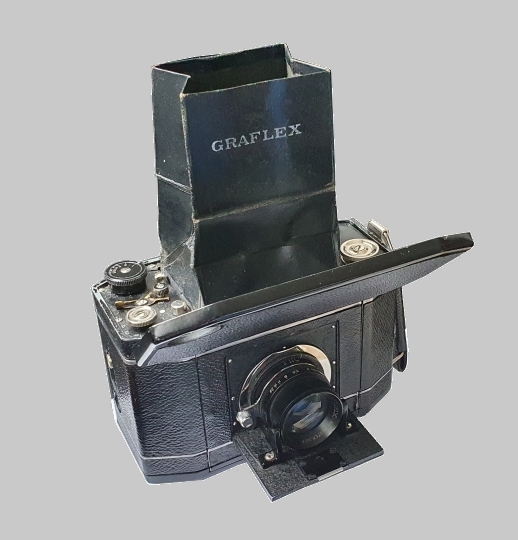
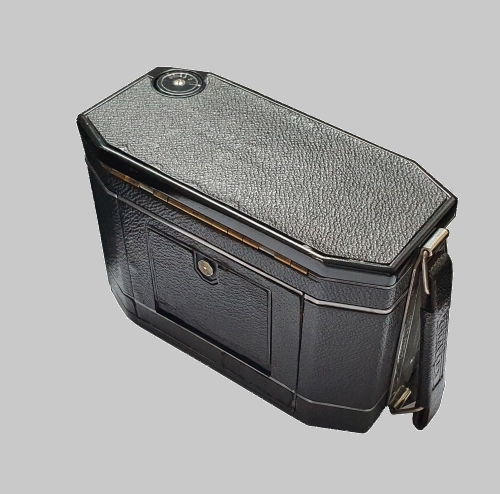
Photos: Jo Lommen
Graflex Series II
Patented November 13, 1934
"This invention, relating as it does to photographic cameras of a very compact type, is intended to render as simple as possible the art of picture‑making while providing means to obtain a correct exposure. To effect this result a number of different factors enter into the problem and in order to solve the problem correctly, it has been necessary to co‑relate the various elements or factors of the camera in such a manner that while preserving all the efficiency of a camera of large bulk and considerable weight, the camera has been reduced to a relatively small compass and relatively small weight. This has been done without sacrificing in any respect the efficiency and accurateness of the large camera to which we have referred and which is known upon the market as the "Graflex" camera. The novel features of the invention will be evident from the detailed description of the parts as shown in the drawings."
The above text can
be found on the official US Patent office under number 1,980,546 and relates to
the Graflex National camera which is
a relatively small single lens reflex camera. There were two versions, Series 1(1933-1935)
and its successor the Series II (1934-1941). The major differences between those two are:
the red film counter window, the mirror set level, the cable release socket and
a hidden spring somewhere in the mechanics. The Series II has a slider in front of the red window.
The mirror set lever changed place from the left to the right side. Series 1 misses the
wind lockout lever spring inside the
mechanics which is part
of the wind shutter gear in the Series II. Furthermore a new designed cable release socket
was placed on the right side of the Series II.
The camera is only13,8 cm long x 6,5 cm width x 9
cm high and weights 935 grams or 2,06 lb It
exist out of an outer case covering the inner camera which can be taken off for
loading a 120 film. The camera controls as well as the viewing hood are hidden
by a hinged cover with a hole, in closed position showing only the shutter
winding knob figures. Film size is 10 negatives 2 ¼ x 2 ½ inch.
We are looking at a characteristic designed all American 120 roll film reflex
camera equiped with a self erecting viewing hood, collapsible lens door and hinged top cover,
made by Folmer Graflex Corporation-Rochester, NY. If
closed it looks like a lunch box, if opened it shows all its lovely shiny
manual controls. Like almost every reflex camera at that time, the National is equipped with a focal plane shutter which travels in
horizontal direction from the left to the right. In fact the shutter exist out
of two independent controlled blinds thus creating an adjustable vertical slit.
Unlike the National, all other focal plane shutter cameras ever manufactured by Graflex,
were equipped with a long focal plane shutter made out of rubberised fabric with build in
4 or 5 fixed different
sized horizontally slits.
The
variable National focal plane shutter slit should be set after winding. The
corresponding number can be found on the Shutter Speed Tag on the back of the viewing
hood. There are as much as 9 different settings from 1/30 to 1/500 sec.
The National Graflex was
marketed as a camera more or less suitable for woman probably because of its
small size. However, the National was a general purpose miniature camera capable
of the most precise photographic accomplishment, albeit not easy to handle for
the amateur photographer due to its complicated shutter setting protocol. On the
other hand the National camera has a lot of features such as direct full view
focusing by the mirror and ground glass. Even a good working build in
collapsible magnifier
is a standard feature. Graflex advertisement promised: "eliminates Picture
Taking Guess work".
The garden shed. View through the build in magnifier - part of the collapsible viewing hood.
Takes 10 pictures 2 ¼ x 2 ½ inch on 120 film- 8 Exposures roll film. Furthermore a good working film counter coupled to an automatic film winding stop once the next frame has been positioned. The lens is a B&L Tessar series 1c f=3,5. An exposure guide on the inside of the top cover shows the calculated shutter speed and lens setting for under all thinkable conditions. Interchangeable lens Series II only. Available lenses B&L Tessar f=3,5 75 mm and B&L Telephoto f=6,5 140 mm.
The National nicknamed “lunchbox” and also
known as a "hefty little brick", is a
compact build single lens reflex camera and is far from easy to use.
Some precautions have to be made before taking
photos.
I'm sure afterwards you will be glad you read this before fiddling around.
The exact protocol must be followed to prevent serious damage.
Open Camera to Start
1) open lens door by pushing front knob down.
2) Open top cover.
3) Pull mirror level E
4) Fold viewing hood down
5) turn winding knob clockwise
6) release viewing hood
7) Set shutter speed by lifting knurled knob L and turning into desired
numbered position.
8) Drop knurled knob L back in lower position.
CLOSING
Set mirror lever E in focusing posing
Push lensboard inwards until light resistance is felt which blocks the push back
setting.
While holding that position press down release button and the hinged lens board
will go inside completely.
Always...
1) open lens door before opening hinged top cover.
2)
set mirror lever E in focusing position before winding the winding shutter knob K
3)
make sure the lens is locked in shooting position before winding K.
4)
set mirror in focusing position by pulling lever E before closing lens door.
Film Loading
The camera casing is made up
of two main members. The casing member comprises the camera bottom and a
surrounding shell with opening for the pivoted lens door of the inner camera.
The camera and outer housing are held together by two locking studs to be slid
in lengthwise slots in the bottom of the inner camera to engage or disengage.


These slots are situated on
the bottom inside the mirror house and are part of the mirror catch assembly.
First open the camera by lifting the outer shell off the camera.
This can be done by sliding both bottom catches (photo 2) to "O". To separate inner from
outer case grasp camera firmly with your left hand with your left thumb next to
the hinged lens door. With your right hand open, place the finger nail of your
right thumb in the slit 1 cm right under the hinged door and pull. The inner
case will drop in your right hand.
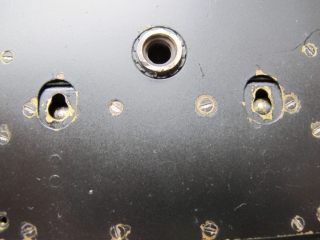
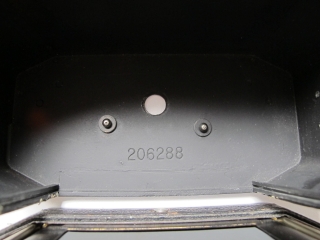
Before starting one thing that needs to be taken care of.
You may ruin this camera if you do not respect the roll film type. It has to be
the 120 type spool with the bigger hole at the end of the spool. The picture
below shows the one with the wooden pivot is the right one. The other spool
would not fit exactly into the film holder reason why the camera would not fit
anymore into the housing. Trying to close the camera with force may lead to oust
the mirror house which disables the release of the mirror.
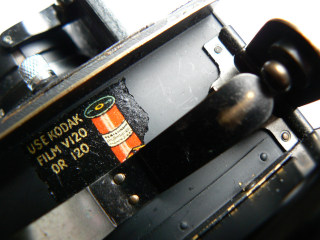

Now we're ready to start loading the roll film into the camera.
Pull bulb release lever (J) to make sure shutter is released.
Slide cover catches W to (O) open. Separate inner from outer case. Open
cover.
Insert empty spool in spool chamber under winding knob D so
that the slot engages properly. Remove sticker from film. Holding film release
knob in direction of arrow, unroll sufficient film to reach take up spool and thread into long slot . Turn the
winding knob D until the film is taut.
Place the bottom of the outer case back on the camera making sure that it is seated against the top. While pressing the bottom firmly into place slide the catches W toward (C) closed.
While holding film release G in direction of arrow, wind the
film with knob D until number 1 appears in the centre of the ruby window
R
Holding the release G toward arrow, pull up on the indicator knob G permitting it to turn freely until the pointer is just clear of the starting position S toward the number 9. Release G and turn winding knob D until the film is wound taut. The film is now in position for the first exposure.
We skip determining the correct speed number and focusing to continue with
Shutter setting
First with the mirror set in the viewing position by pulling lever E, turn the Shutter Winding Knob (K) in a clockwise direction as far as possible.
DO NOT TRY TO CHANGE THE SPEED NUMBER WHEN THE SHUTTER HAS BEEN FIRED
ALWAYS WIND THE SHUTTER FIRST.
Then choose one of
the 9 shutter speeds. (On the back of the viewing hood there is a table which gives the values (1/30th to 1/500th sec)
To change shutter from a higher to a lower
number, pull up on winding knob (this will separate outside knurled ring) and
turn it clockwise direction until desired number is aligned with the white
marker on outside ring (slight pressure required). If desired number is aligned
with white marker, drop winding knob back in lower position.
To change from a lower to a higher number pull up on knob and turn outside
knurled ring in counter clockwise direction and let go if desired number is
okay.
Unlike the traditional pre-war Graflex focal plane shutter which has 6 different roller spring tensions and the Speed Graphic Pacemaker which has only 2, the National has a focal plane shutter which travels always at the same speed. The exposure time can be controlled just by changing the width of the slit. On the inside of the top cover you'll find a quite interesting exposure calculator using variables such as the Time of Day, Dull Hazy of Bright and the months of the year for groups, portraits, street landscape etc, etc. Inside the pop up hood there is a build in magnifier for fine tuning the focused image on the ground glass.

Several mechanical improvements were made comparing to the Series I, such as a provision for cable release and the mirror cocking lever from the right to the left.
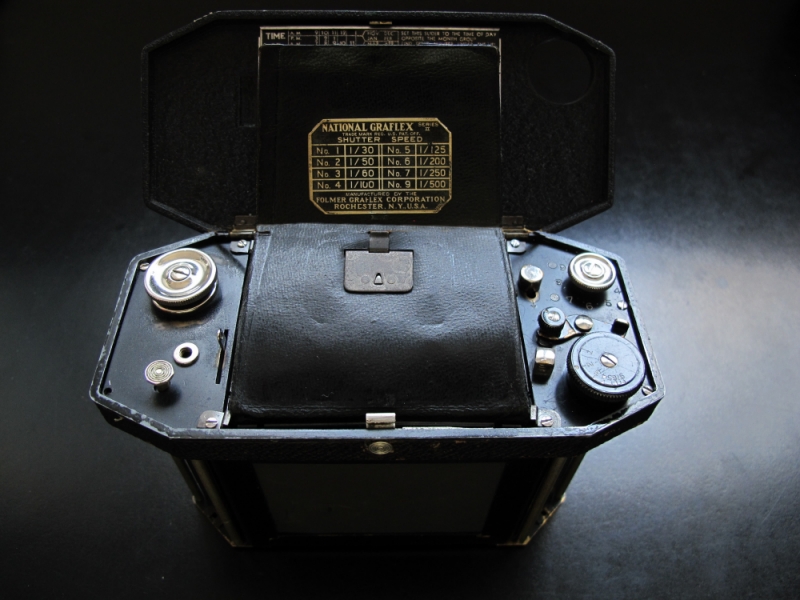
Lens changing by lifting the nickel finished hors shoe
clip directly back of the focusing lever free from the lens board.
Slip the lens
out of its fitting and lay it apart.
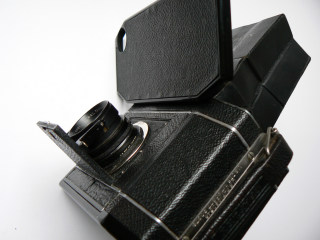
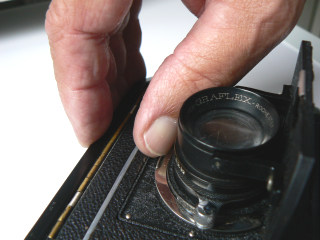
So far
this was just a very brief introduction meant to help you to get started for the first time.